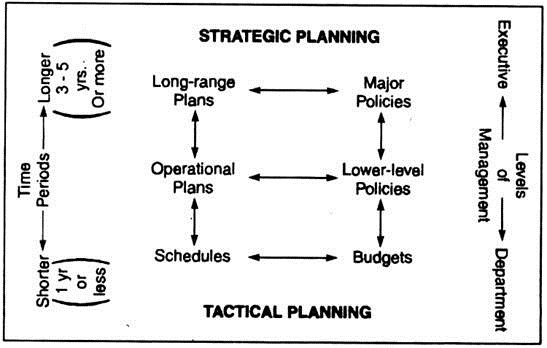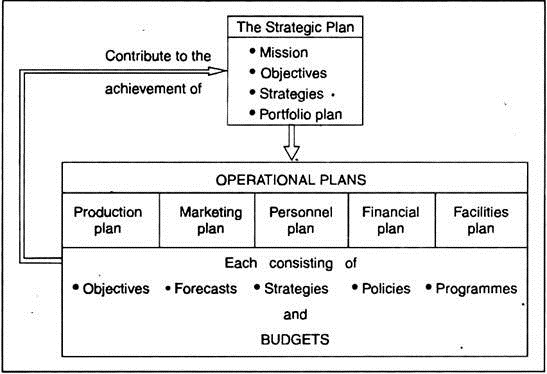The nature and kind of planning activities carried out in firms are discussed as follows:- 1. Strategic Planning Activities 2. Operational Planning Activities 3. Budgetary Planning Activities. Also learn about the relationships among them.
1. Strategic Planning Activities:
These are longer-term in nature, involve top-level executives and more global in their effect on the firm.
These consist of:
(a) Establishing the overall identity of the company,
(b) Deciding on the strategic alternatives the company will follow, and
(c) Choosing the tactics or weapons which, the company will emphasise.
The strategic planning can be carried out at many levels in a firm and is applicable at:
(i) The business unit level,
(ii) The product level, and
(iii) The corporate level for the multi-business firm.
2. Operational Planning Activities:
These require establishing major policies and also planning activities which are longer-term and broader in effect.
Operational planning activity (for example, planning for major facility additions) and policy formulation (for example, establishing whether the firm will continue to market through manufacturing representatives or initiate its own sales force) are usually carried out within a broader strategic framework. These are also referred to as long-range planning and more recently, are viewed as planning activities of strategic nature.
3. Budgetary Planning Activities:
These include establishing budgets, schedules, and departmental policies. These activities involve shorter-term focus and lower level managers. These are applicable at all levels of an organisation’s management.
Relationships among them:
The relationships between the various planning activities can be expressed in the diagram below:
 The planning activities can be initiated from the top—top-down planning or from the bottom—bottom-up planning.
The planning activities can be initiated from the top—top-down planning or from the bottom—bottom-up planning.
The strategic planning is not a one-year budget. Even then, the one-year budget should reflect the strategic plan. Nor is the strategic plan that gives a five-year forecast. Again, the five-year forecast (of sales, profits, production capacity, budgets, sales and marketing, etc.) should reflect the strategic plan.
These forecasts and long-range budgets are ‘Operational plans’. In other words, the operational plans, especially long-range plans, emanate from the overall strategic plan.
To be more specific and detailed, the relationships between the strategic planning, operational planning and budgetary planning can be illustrated in a diagram below. The focus of the planning and the time perspectives will, of course, differ.
The strategic planning provides direction for an organisation’s mission, objectives and strategies, facilitating the development of plans for each of the organisation’s functional areas. A complete strategic plan guides each area in the direction that the organisation wishes to go and allows each area to develop objectives, strategies, policies and programmes and budgets consistent with those goals.
The diagram above indicates clearly that all plans should be derived from the strategic plan while at the same time contributing to the achievement of the strategic plan.
The operating managers in an organisation are not expected directly to be involved in the development of a firm’s strategic plan.
However, they can be involved in the strategic planning process in two ways:
(i) They usually influence the process by providing inputs in the form of information and suggestions relating to their own areas of responsibility; and
(ii) They must be made aware of planning as well as results of their own areas of responsibility.
